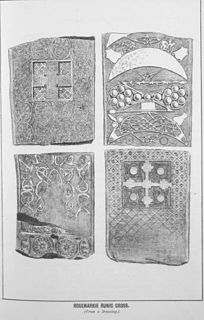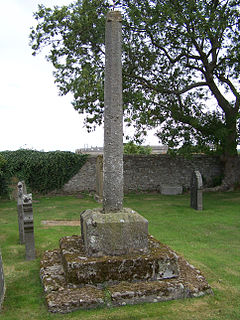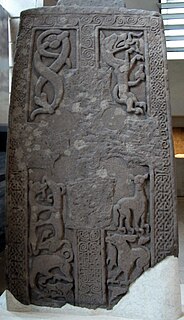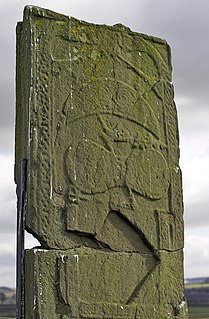Related Research Articles

The Picts were a group of peoples who lived in what is now northern and eastern Scotland during Late Antiquity and the Early Middle Ages. Where they lived and what their culture was like can be inferred from early medieval texts and Pictish stones. Their Latin name, Picti, appears in written records from the 3rd to the 10th century. Early medieval sources report the existence of a distinct Pictish language, which today is believed to have been an Insular Celtic language, closely related to the Brittonic spoken by the Britons who lived to the south.

A high cross or standing cross is a free-standing Christian cross made of stone and often richly decorated. There was a unique Early Medieval tradition in Ireland and Britain of raising large sculpted stone crosses, usually outdoors. These probably developed from earlier traditions using wood, perhaps with metalwork attachments, and earlier pagan Celtic memorial stones; the Pictish stones of Scotland may also have influenced the form. The earliest surviving examples seem to come from the territory of the Anglo-Saxon kingdom of Northumbria, which had been converted to Christianity by Irish missionaries; it remains unclear whether the form first developed in Ireland or Britain.

A Pictish stone is a type of monumental stele, generally carved or incised with symbols or designs. A few have ogham inscriptions. Located in Scotland, mostly north of the Clyde-Forth line and on the Eastern side of the country, these stones are the most visible remaining evidence of the Picts and are thought to date from the 6th to 9th century, a period during which the Picts became Christianized. The earlier stones have no parallels from the rest of the British Isles, but the later forms are variations within a wider Insular tradition of monumental stones such as high crosses. About 350 objects classified as Pictish stones have survived, the earlier examples of which holding by far the greatest number of surviving examples of the mysterious symbols, which have long intrigued scholars.
Portmahomack is a small fishing village in Easter Ross, Scotland. It is situated in the Tarbat Peninsula in the parish of Tarbat. Tarbat Ness Lighthouse is about three miles from the village at the end of the Tarbat Peninsula. Ballone Castle lies about one mile from the village. There is evidence of early settlement, and the area seems to have been the site of significant activity during the time of the Picts, early Christianity and the Vikings. The village is situated on a sandy bay and has a small harbour designed by Thomas Telford: it shares with Hunstanton the unusual distinction of being on the east coast but facing west. Portmahomack lies inside the Moray Firth Special Area of Conservation with the associated dolphin and whale watching activity.

Celtic art is associated with the peoples known as Celts; those who spoke the Celtic languages in Europe from pre-history through to the modern period, as well as the art of ancient peoples whose language is uncertain, but have cultural and stylistic similarities with speakers of Celtic languages.

The Clach a' Charridh or Shandwick Stone is a Class II Pictish stone located near Shandwick on the Tarbat peninsula in Easter Ross, Scotland. It is a scheduled monument.

The Hilton of Cadboll Stone is a Class II Pictish stone discovered at Hilton of Cadboll, on the East coast of the Tarbat Peninsula in Easter Ross, Scotland. It is one of the most magnificent of all Pictish cross-slabs. On the seaward-facing side is a Christian cross, and on the landward facing side are secular depictions. The latter are carved below the Pictish symbols of crescent and v-rod and double disc and Z-rod: a hunting scene including a woman wearing a large penannular brooch riding side-saddle. Like other similar stones, it can be dated to about 800 AD.

The Nigg Stone is an incomplete Class II Pictish cross-slab, perhaps dating to the end of the 8th century.

The Ardjachie Stone is an uncut but decorated red sandstone boulder discovered by farmers in 1960 on the Ardjachie Farm in the Tarbat peninsula of Easter Ross. It now stands outside of the museum of Tain. On it are depicted several dozen cup or ring marks probably dating to the Bronze Age. It also has an inverted-L design with a wheel image above, both of probable Pictish origin. It therefore may be considered a Class I Pictish stone.

The Rosemarkie Stone or Rosemarkie Cross, a Class II Pictish stone, is one of the major surviving examples of Pictish art in stone.

The Rosemarkie sculpture fragments are the Pictish slabs and stone fragments other than the main Rosemarkie Stone which have been discovered in Rosemarkie, on the Black Isle of Easter Ross. There are fourteen in all. Perhaps the most widely known is the so-called Daniel Stone. The latter is so named because of the tendency among scholars and enthusiasts of Pictish art to give every Pictish stone a Christian interpretation. In this case, the depiction of a man's head at the jaws of a wolf-like beast is supposed to depict the Old Testament story of Daniel in the Lion's Den. The stones are all of likely Christian origin, and share a similar style with the art of Iona. Some of them may have been of funerary purpose, as coffin lids, while others may have formed part of a larger stone. These stones are usually displayed in the Groam House Museum of Rosemarkie.
Martin Oswald Hugh Carver, FSA, Hon FSA Scot, is Emeritus Professor of Archaeology at the University of York, England, director of the Sutton Hoo Research Project and a leading exponent of new methods in excavation and survey. He specialises in the archaeology of early Medieval Europe. He has an international reputation for his excavations at Sutton Hoo, on behalf of the British Museum and the Society of Antiquaries and at the Pictish monastery at Portmahomack Tarbat, Easter Ross, Scotland. He has undertaken archaeological research in England, Scotland, France, Italy and Algeria.

The Eassie Stone is a Class II Pictish stone of about the mid 8th century AD in the village of Eassie, Angus, Scotland. The stone was found in Eassie burn in the late 18th century and now resides in a purpose-built perspex building in the ruined Eassie church.

The Meigle Sculptured Stone Museum is a permanent exhibition of 27 carved Pictish stones in the centre of the village of Meigle in eastern Scotland. It lies on the A94 road running from Coupar Angus to Forfar. The museum occupies the former parish school, built 1844. The collection of stones implies that an important church was located nearby, or perhaps a monastery. There is an early historical record of the work of Thana, son of Dudabrach, who was at Meigle in the middle of the 9th century during the reign of King Pherath. Thana was likely to have been a monk serving as a scribe in a local monastery that could have been founded in the 8th century. The stones contained in the museum were all found near Meigle, mostly in the neighbouring churchyard or used in the construction of the old church. The present church building dates to about 1870, the previous building having been destroyed in a fire on 28 March 1869. The stones were rescued by William Galloway immediately after the fire. The stones are Christian monuments to the dead of the Pictish warrior aristocracy, who are depicted on the stones bearing their weapons or hunting.

The Glamis Manse Stone, also known as Glamis 2, is a Class II Pictish stone at the village of Glamis, Angus, Scotland. Dating from the 9th century, it is located outside the Manse, close to the parish church. It is inscribed on one side with a Celtic cross and on the other with a variety of Pictish symbols. It is a scheduled monument.

Kinneddar is a small settlement on the outskirts of Lossiemouth in Moray, Scotland, near the main entrance to RAF Lossiemouth. Long predating the modern town of Lossiemouth, Kinneddar was a major monastic centre for the Pictish kingdom of Fortriu from the 6th or 7th centuries, and the source of the important collection of Pictish stones called the Drainie Carved Stones. The Kirk of Kinneddar was the cathedral of the Diocese of Moray between 1187 and 1208, and remained an important centre of diocesan administration and residence of the Bishop of Moray through the 13th and 14th centuries.

The Woodwrae Stone is a Class II Pictish Stone that was found in 1819 when the foundations of the old castle at Woodwrae, Angus, Scotland were cleared. It had been reused as a floor slab in the kitchen of the castle. Following its removal from the castle, it was donated to the collection of Sir Walter Scott at Abbotsford House. It is now on display at the Museum of Scotland in Edinburgh.

St Orland's Stone is a Class II Pictish Cross-Slab at Cossans, near Kirriemuir and Forfar, Angus, Scotland

Art in Medieval Scotland includes all forms of artistic production within the modern borders of Scotland, between the fifth century and the adoption of the Renaissance in the early sixteenth century. In the early Middle Ages, there were distinct material cultures evident in the different federations and kingdoms within what is now Scotland. Pictish art was the only uniquely Scottish Medieval style; it can be seen in the extensive survival of carved stones, particularly in the north and east of the country, which hold a variety of recurring images and patterns. It can also be seen in elaborate metal work that largely survives in buried hoards. Irish-Scots art from the kingdom of Dál Riata suggests that it was one of the places, as a crossroads between cultures, where the Insular style developed.

The Burghead Bulls are a group of carved Pictish stones from the site of Burghead Fort in Moray, Scotland, each featuring an incised image of a bull. Up to 30 were discovered during the demolition of the fort to create the town of Burghead in the 19th century, but most were lost when they were used to build the harbour quayside. Six remain: two in the Visitor Centre in Burghead, two in Elgin Museum, one in the National Museum of Scotland in Edinburgh, and one in the British Museum in London.
References
- Fraser, Iain, Ritchie, J.N.G., et al., Pictish Symbol Stones: An Illustrated Gazetteer, (Royal Commission on the Ancient and Historical Monuments of Scotland, 1999)
- Carver, Martin Sculpture in Action: contexts for stone carving on the Tarbat peninsula, Easter Ross in Sally M Foster and Morag Cross (eds) Able Minds and Practised Hands. Scotland's Early Medieval Sculpture in the 21st century(Historic Scotland, 2005): 13–36.